Filter by
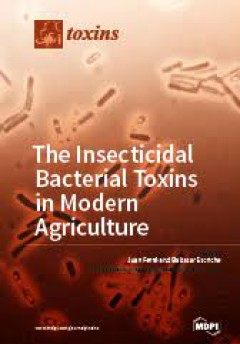
The Insecticidal Bacterial Toxins in Modern Agriculture
Increased awareness about environmental adverse effects of human activities has prompted the use of insecticides with low impact on systems associated to agriculture. Currently, the most successful biological products are based on protein toxins from the bacterial species Bacillus thuringiensis. Because of the remarkable properties of these proteins, their encoding genes were introduced into fa…
- Edition
- -
- ISBN/ISSN
- 978-3-03842-663-9
- Collation
- -
- Series Title
- -
- Call Number
- 630 INS

Economics and Ecology of Diversification
The monoculture systems that have been encouraged by governments since the 1960s have led to major socio-economic and environmental crises. Now the diversification of tree crop systems is advancing throughout the tropics. Why and when does diversification take place? What categories of farmers diversify? What obstacles do they have to overcome, and how do public and private policies interfere i…
- Edition
- 1
- ISBN/ISSN
- 978-94-017-7293-8
- Collation
- -
- Series Title
- 92 b/w illustrations, 9 illustrations in colour
- Call Number
- IX, 340

Beneficial Microorganisms in Agriculture, Aquaculture and Other Areas
This book focuses on the use of microorganisms in relation to agriculture, aquaculture and related fields, ranging from biofertilizers to poultry production. The latest innovations are also included to provide insights into the unlimited potentials of microorganisms in these areas. Individual chapters explore topics such as probiotics in poultry, biopurification of wastewater, converting agrow…
- Edition
- -
- ISBN/ISSN
- 978-3-319-23183-9
- Collation
- VIII, 220
- Series Title
- -
- Call Number
- 630

Nanotechnology and Plant Sciences: Nanoparticles and Their Impact on Plants
This book presents a holistic view of the complex and dynamic responses of plants to nanoparticles, the signal transduction mechanisms involved, and the regulation of gene expression. Further, it addresses the phytosynthesis of nanoparticles, the role of nanoparticles in the antioxidant systems of plants and agriculture, the beneficial and harmful effects of nanoparticles on plants, and the app…
- Edition
- 1
- ISBN/ISSN
- 978-3-319-36211-3
- Collation
- XII
- Series Title
- -
- Call Number
- -
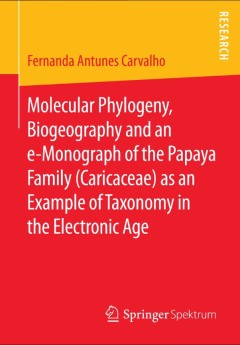
Molecular Phylogeny, Biogeography and an e-Monograph of the Papaya Family (Ca…
Fernanda Antunes Carvalho addresses an issue of key importance to the field of systematics, namely how to foster taxonomic work and the dissemination of scientific knowledge about species by taking full advantage of electronic data and bioinformatics tools. The first part focuses on the development of an electronic monograph of the papaya family (Caricaceae) using existing infrastructures of In…
- Edition
- 1
- ISBN/ISSN
- 978-3-658-10266-1
- Collation
- XIV, 147
- Series Title
- -
- Call Number
- -

Basic Steps in Geostatistics: The Variogram and Kriging
This brief will provide a bridge in succinct form between the geostatistics textbooks and the computer manuals for `push-button' practice. It is becoming increasingly important for practitioners, especially neophytes, to understand what underlies modern geostatistics and the currently available software so that they can choose sensibly and draw correct conclusions from their analysis and mappin…
- Edition
- -
- ISBN/ISSN
- -
- Collation
- X, 100
- Series Title
- -
- Call Number
- 630
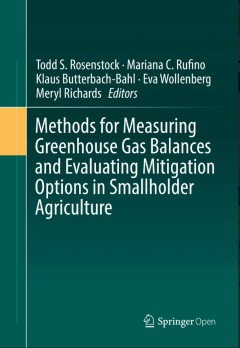
Methods for Measuring Greenhouse Gas Balances and Evaluating Mitigation Optio…
This book provides standards and guidelines for quantifying greenhouse gas emissions and removals in smallholder agricultural systems and comparing options for climate change mitigation based on emission reductions and livelihood trade-offs. Globally, agriculture is directly responsible for about 11% of annual greenhouse gas (GHG) emissions and induces an additional 17% through land use change,…
- Edition
- 1
- ISBN/ISSN
- 978-3-319-29792-7
- Collation
- XV, 203
- Series Title
- -
- Call Number
- -
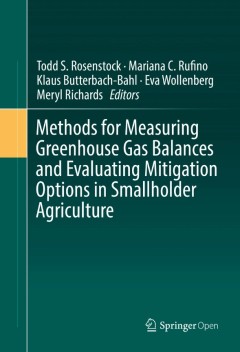
Methods for Measuring Greenhouse Gas Balances and Evaluating Mitigation Optio…
This book provides standards and guidelines for quantifying greenhouse gas emissions and removals in smallholder agricultural systems and comparing options for climate change mitigation based on emission reductions and livelihood trade-offs. Globally, agriculture is directly responsible for about 11% of annual greenhouse gas (GHG) emissions and induces an additional 17% through land use change,…
- Edition
- 1
- ISBN/ISSN
- 978-3-319-29792-7
- Collation
- XV, 203
- Series Title
- -
- Call Number
- -
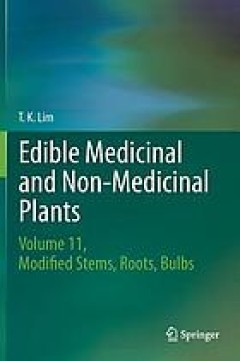
Edible Medicinal and Non-Medicinal Plants : Volume 10, Modified Stems, Roots,…
This book continues as volume 10 of a multi-compendium on Edible Medicinal and Non-Medicinal Plants. It covers such plants with edible modified storage subterranean stems (corms, rhizomes, stem tubers) and unmodified subterranean stem stolons, above ground swollen stems and hypocotyls, storage roots (tap root, lateral roots, root tubers), and bulbs, that are eaten as conventional or functional …
- Edition
- -
- ISBN/ISSN
- 9789401772761
- Collation
- -
- Series Title
- -
- Call Number
- 630
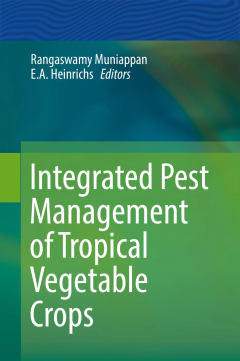
Integrated Pest Management of Tropical Vegetable Crops
It is an edited book with chapters written by multi-disciplinary specialists in their specific subject areas. It covers development of IPM components and packaging them for individual vegetable crops specifically targeted to tropical countries. Scientific background for IPM components or tactics will be included. There will be case studies of IPM packages developed and implemented in different …
- Edition
- -
- ISBN/ISSN
- 978-94-024-0922-2
- Collation
- XIX, 304
- Series Title
- -
- Call Number
- 630 INT
 Computer Science, Information & General Works
Computer Science, Information & General Works  Philosophy & Psychology
Philosophy & Psychology  Religion
Religion  Social Sciences
Social Sciences  Language
Language  Pure Science
Pure Science  Applied Sciences
Applied Sciences  Art & Recreation
Art & Recreation  Literature
Literature  History & Geography
History & Geography